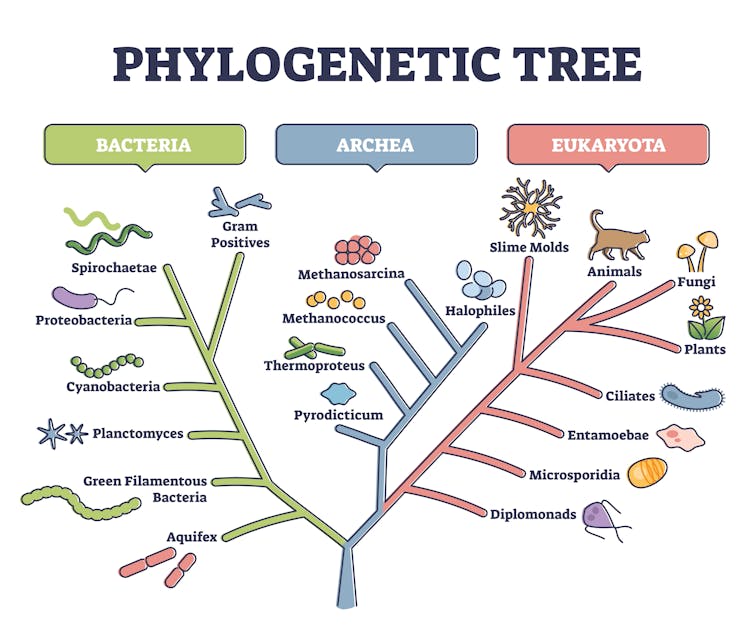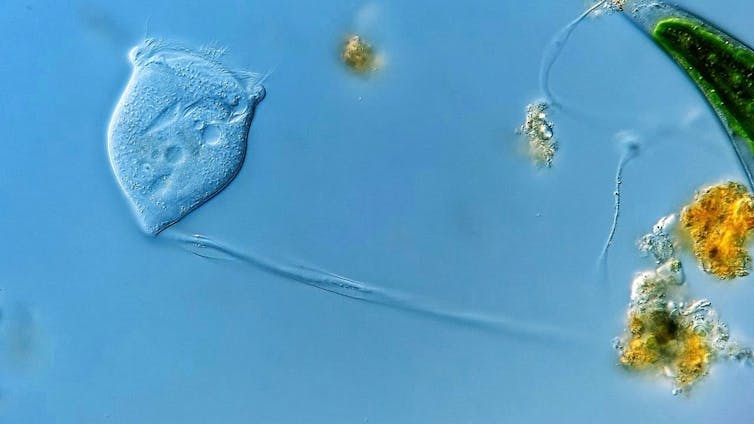
You are more likely to take a trip to the Moon than to see a microbe called Legendrea loyezae under a microscope. Nasa’s Apollo programme has sent a total of 24 people to the Moon between 1968 and 1972. Only four people (including us) have ever found Legendrea loyezae from its discovery in 1908 to our recently published study.
Considering the expense, it makes sense that the number of people who journeyed to the Moon would be low. But peeking into the microscopic realm doesn’t require a billion-dollar budget, only a microscope and someone willing to sit in front of it.
Our recent study uncovered 20 new species of microbes as well as 100 rare ones. Each DNA specimen we find gives another piece of the evolution puzzle. Scientists can use this jigsaw to analyse how an organism works. For example, some genes hint about how a being respires. Or it can give information about the organism’s place on the tree of life.
The reason so few scientists have seen these microbes is because undersampling is a major issue. This means most research teams take samples from only a few or even just one location.
Our most recent investigation, which took two years, involved the collection and investigation of well over 1,000 samples. From the lakes and ponds in Warsaw, Poland, to marine sediments in the North Sea, and the Mediterranean off the coasts of Italy and Portugal, to chalk streams in Dorset, UK we searched for microbes. And it paid off: we found more than 500 species, including the rare and new ones.
Microbiology is human history
The first life on Earth appeared in water as creatures too small for the human eye to see and stayed that way for billions of years. Microbes live all around us. They can be found in any habitat, from puddles to oceans. But there is still so much we don’t know about them. Some of these microscopic organisms evolved from simple to more complex beings, eventually giving rise to all the visible life around us. Others have hardly changed and kept their minute size.
Microorganisms were the first predators on Earth and their greedy appetites drove the evolution of more complex life in the early ages of Earth’s history. After the evolution of complex life, microbes became the main food source for other creatures such as krill and plankton, which in turn are food for larger species. If the organisms at the very bottom of the food chain disappeared, all other parts above them would collapse too.
The timescale of this is so long it’s hard to grasp. If we squeezed Earth’s 4.5 billion years old history into a single year, life would exist on a microscopic scale until the end of October. Humans would appear on the last 30 minutes of the year, and we would be aware of the existence of the microbes just less than three seconds before the new year.

The Tree of Life shows how organisms are related to each other. Looking at it, you can see most life on Earth is still micro scale, with animals, plants and fungi restricted to a small cluster of branches within the eukarya group. In contrast to the other two groups, archaea and bacteria, eukarya members store their DNA in the cell nucleus.
A microscopic rarity
Legendrea loyezae is in the ciliates branch of eukarya. Oxygen is lethal for Legendrea loyezae and it has tentacles that stretch and contract to catch prey. Scientists have discovered thousands of ciliate species.
Ciliates live in aquatic environments, thin water films in soils and even places where there is no oxygen. Although their lives depend on water, they can form protective structures to stay dormant until they get wet again. They are composed of only a single cell and yet they are wondrously diverse. Ciliates have interesting hunting strategies – some types specialise in eating filaments of cyanobacteria, which they suck up like spaghetti. They can swim. Others have a sedentary lifestyle, including Vorticella, which has a stalk to attach itself to submerged surfaces.

Some ciliate species form permanent, physical relationships with other groups of organisms, something known as symbiosis. For example, they can harbour green algae inside themselves to eat the sugar the algae produce through photosynthesis. In exchange, they protect the algae from larger algae-grazers and viruses (yes, even algae can get viral infections).

Some ciliate species live in densely populated communities, especially in well-oxygenated environments. But others live in such small numbers that finding them is like searching for a thousand needles in a haystack the size of Mount Everest.
Our goal is to find as many of these rare and unusual species as we can. We use our knowledge of species’ ecology as clues. If we know that a microbe prefers to live in dark, oxygen-free habitats we don’t look for it on the surface of the water where there is plenty of oxygen and light. It took thousands of hours looking through a microscope to find four Legendrea loyezae, not to mention a small fortune on physiotherapy for our cricked necks and aching backs.
Why microbes matter
It’s easy to feel detached from the invisible microbes. Most of us will never get to see one magnified enough for our eyesight to pick up. But learning about microbes has helped inform some of the most important scientific discoveries in history. Microbes take life as they inflict animal and plant diseases and develop massive blooms in the sea that wipe out aquaculture farms.
But we couldn’t live without them. Microbes are responsible for the survival of our ecosystems and for their recovery after damage such as pollution or climate change. We can’t grow food without microorganisms. They clean our sewage. Some can produce antibiotics and other drugs, others are involved in the production of food.
So exploring the microbial world is well worth the backache.
Genoveva Esteban receives funding from the European Union and other funding organisations. She works for Bournemouth University.
James Weiss does not work for, consult, own shares in or receive funding from any company or organisation that would benefit from this article, and has disclosed no relevant affiliations beyond their academic appointment.
This article was originally published on The Conversation. Read the original article.







